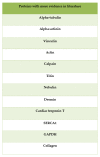Systematic Review on Post-Mortem Protein Alterations: Analysis of Experimental Models and Evaluation of Potential Biomarkers of Time of Death
- PMID: 35741301
- PMCID: PMC9222196
- DOI: 10.3390/diagnostics12061490
Systematic Review on Post-Mortem Protein Alterations: Analysis of Experimental Models and Evaluation of Potential Biomarkers of Time of Death
Abstract
Estimating the post-mortem interval (PMI) is a very complex issue due to numerous variables that may affect the calculation. Several authors have investigated the quantitative and qualitative variations of protein expression on post-mortem biological samples in certain time intervals, both in animals and in humans. However, the literature data are very numerous and often inhomogeneous, with different models, tissues and proteins evaluated, such that the practical application of these methods is limited to date. The aim of this paper was to offer an organic view of the state of the art about post-mortem protein alterations for the calculation of PMI through the analysis of the various experimental models proposed. The purpose was to investigate the validity of some proteins as "molecular clocks" candidates, focusing on the evidence obtained in the early, intermediate and late post-mortem interval. This study demonstrates how the study of post-mortem protein alterations may be useful for estimating the PMI, although there are still technical limits, especially in the experimental models performed on humans. We suggest a protocol to homogenize the study of future experimental models, with a view to the next concrete application of these methods also at the crime scene.
Keywords: forensic pathology; post-mortem interval; proteins; time of death.
Conflict of interest statement
The authors declare no conflict of interest.
Figures






Similar articles
-
Histological transformations of the dental pulp as possible indicator of post mortem interval: a pilot study.Forensic Sci Int. 2017 Oct;279:251-257. doi: 10.1016/j.forsciint.2017.09.001. Epub 2017 Sep 11. Forensic Sci Int. 2017. PMID: 28934683
-
Determining the time of death by morphological and immunohistochemical evaluation of collagen fibers in postmortem gingival tissues.Leg Med (Tokyo). 2019 Jul;39:1-8. doi: 10.1016/j.legalmed.2019.05.002. Epub 2019 May 7. Leg Med (Tokyo). 2019. PMID: 31078972
-
Proteomic Characterization of Changes in Mouse Brain Cortex Protein Expression at Different Post-Mortem Intervals: A Preliminary Study for Forensic Biomarker Identification.Int J Mol Sci. 2024 Aug 10;25(16):8736. doi: 10.3390/ijms25168736. Int J Mol Sci. 2024. PMID: 39201424 Free PMC article.
-
MicroRNAs as Useful Tools to Estimate Time Since Death. A Systematic Review of Current Literature.Diagnostics (Basel). 2021 Jan 3;11(1):64. doi: 10.3390/diagnostics11010064. Diagnostics (Basel). 2021. PMID: 33401603 Free PMC article. Review.
-
New Trends in Immunohistochemical Methods to Estimate the Time since Death: A Review.Diagnostics (Basel). 2022 Aug 31;12(9):2114. doi: 10.3390/diagnostics12092114. Diagnostics (Basel). 2022. PMID: 36140515 Free PMC article. Review.
Cited by
-
Development of Mathematical Models Using circRNA Combinations (circTulp4, circSlc8a1, and circStrn3) in Mouse Brain Tissue for Postmortem Interval Estimation.Int J Mol Sci. 2025 May 8;26(10):4495. doi: 10.3390/ijms26104495. Int J Mol Sci. 2025. PMID: 40429639 Free PMC article.
-
"Omics" and Postmortem Interval Estimation: A Systematic Review.Int J Mol Sci. 2025 Jan 25;26(3):1034. doi: 10.3390/ijms26031034. Int J Mol Sci. 2025. PMID: 39940802 Free PMC article.
-
Forensic Proteomics for the Discovery of New post mortem Interval Biomarkers: A Preliminary Study.Int J Mol Sci. 2023 Sep 27;24(19):14627. doi: 10.3390/ijms241914627. Int J Mol Sci. 2023. PMID: 37834074 Free PMC article.
-
The mouse gingiva and HIF-1α, a key gene of hypoxic environment, as tools for post-mortem time estimation.PLoS One. 2024 Nov 15;19(11):e0311050. doi: 10.1371/journal.pone.0311050. eCollection 2024. PLoS One. 2024. PMID: 39546465 Free PMC article.
-
Exploring the Early Molecular Pathogenesis of Osteoarthritis Using Differential Network Analysis of Human Synovial Fluid.Mol Cell Proteomics. 2024 Jun;23(6):100785. doi: 10.1016/j.mcpro.2024.100785. Epub 2024 May 14. Mol Cell Proteomics. 2024. PMID: 38750696 Free PMC article.
References
Publication types
LinkOut - more resources
Full Text Sources

